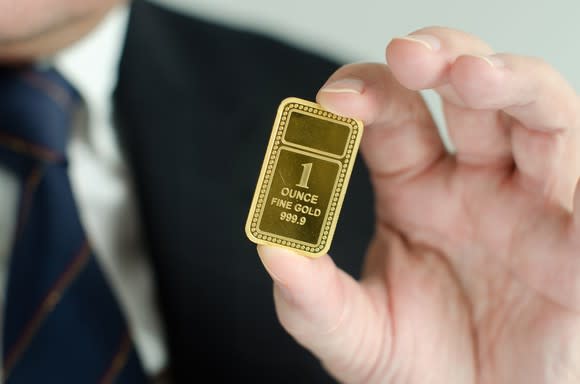Here's How Royal Gold, Inc. Crushed It in 2017
Shares of Royal Gold, Inc. (NASDAQ: RGLD) advanced 30% in 2017, beating the S&P 500 Index by roughly 10 percentage points. That's crushing it in my book. But if investors only look at stock price performance, a lot of important details get missed. So, while this gold, silver, and copper streaming company's huge share price advance was big news, here are some other things you should note about Royal Gold's performance last year.
A golden year
As a streaming and royalty company, Royal Gold provides miners cash up front for the right to buy gold, silver, and copper at reduced rates in the future. That locks in low prices and wide margins. However, at its core, Royal Gold remains a commodity company. So, the price of the commodities it sells will ultimately drive top- and bottom-line results.

Image source: Getty Images.
When it comes to 2017, Royal Gold was better positioned than peers Franco-Nevada Corp. (NYSE: FNV) and Wheaton Precious Metals Corp (NYSE: WPM). The price of gold was up around 13% last year, while silver was down roughly 1%. Royal Gold generates about 75% of its revenues from gold. That's a higher percentage than Franco-Nevada (about 66%) or Wheaton (around 50%). That exposure to gold is one of the reasons behind Royal Gold's strong share price performance.
The truth is, a strong commodity market was probably the main reason for Royal Gold's 2017 stock gain. But there's so much more to understand about 2017.
Some more good news
Although Royal Gold's 1.1% yield is probably an afterthought for most investors, 2017 was the 17th consecutive year of annual dividend increases. And it upped the dividend by roughly 4% in November, as well, meaning 2018 is set up to be year No. 18. This is an incredible streak for a company that operates in a commodity market known for volatile price swings. Extending this dividend streak alone is enough for me to say 2017 was a big success.

Royal Gold's cash generation jumped in 2017. Image source: Royal Gold, Inc.
However, there's still more. For example, during the commodity downturn that started in 2011, Royal Gold was busy inking streaming agreements with cash-strapped miners. With commodity prices heading higher since early 2016, it hasn't had as many opportunities to create new streaming deals. In fact, the company didn't announce a single major deal in 2017. That's not great news, but don't get too upset.
Royal Gold's portfolio includes 195 property interests. Only 40 of those are currently producing. That means it has 155 investments that can be developed for the future. Right now, 41 of those assets are in some stage of development. So, while Royal Gold didn't ink any new deals, it has already bought and paid for assets that will add to its gold and silver production over time. Several of those projects are expected to support production in 2018 as they come online, which means 2017 was a key development year for those projects.

An update on some of the Royal Gold investments that are nearing completion. Image source: Royal Gold, Inc.
With no big deals in the works and a rising gold price, the streaming company saw a nice jump in cash flow in 2017. You might think that counts as crushing it, which it does, but more important to me is what management did with that cash -- up the dividend and strengthen the balance sheet. To put a number on that last one, the company paid down long-term debt by roughly 20% through the first nine months of the year. Notably, the share count was roughly unchanged over that span, so the reduction wasn't an issue of selling stock to pay down debt.
This deserves a little more color. Leverage is a key piece of the streaming business model. Streaming companies like Royal Gold use their balance sheets to finance deals and then either permanently fund those agreements by selling stock to pay down debt, or use the cash generated by the new assets to trim leverage. Royal Gold's use of cash flow to trim debt is a key differentiation because it has been very conservative with its share issuances, which dilute current shareholders. The last material sale took place in 2013, with the share count up 14% since that time. Wheaton's share count is up 24%, and Franco-Nevada's is up 22% over the same span. Staying conservative in 2017 is another big win for Royal Gold and its shareholders in my book.
Digging a little is important
If you are a long-term investor, you shouldn't just be looking at stock price moves when evaluating a company's performance over time. There are other factors that you need to understand because they illustrate important trends and often create the foundation on which future business performance is built. Royal Gold's dividend increase, debt reduction, and broad portfolio of development projects were all important takeaways from 2017 that you could miss if you only consider the 30% stock price advance. And each sets the stage for another good year in 2018.
More From The Motley Fool
Reuben Gregg Brewer has no position in any of the stocks mentioned. The Motley Fool has no position in any of the stocks mentioned. The Motley Fool has a disclosure policy.

 Yahoo Finance
Yahoo Finance 